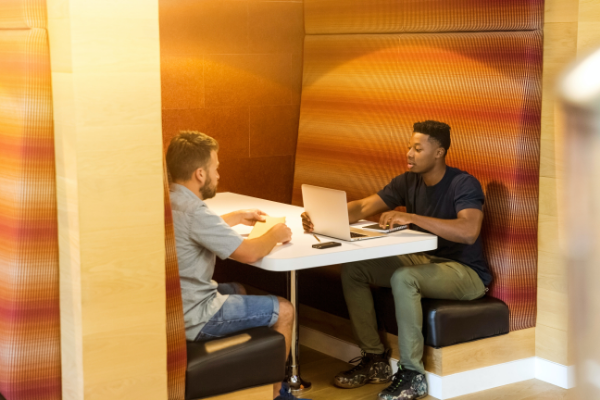Insights
INSIGHTS
All Topics
My Account
Working from home: hybrid working
13 May 2021by Paul Rubens
Mixing home and office working has many benefits. Here are some tips to help charity staff as they begin to move back to the office
Charities around the UK are looking forward to welcoming staff back into their offices as COVID-19 restrictions are slowly lifted. But after the enforced changes in working practices over the last fourteen months, things are unlikely to return to the way they were before the pandemic for a long time, if ever.
That’s because many charities have discovered the advantages of staff working from home – the ability to benefit from the skills of people who live too far away to work in the office or who may have mobility issues, lower office overheads, better work life balance, and less commuting stress, to name just a few.
As a result, many charities are looking to transition from staff working from home to hybrid working. This involves some office-based staff, some home workers, and some hybrid workers: staff members who work some of the time at home and some of the time in the charity office.
For staff transitioning to hybrid working, there are a number of important things to consider.
Office reconfiguration
With a significant number of hybrid workers, most charities will need less dedicated desk space. But that begs the question of where hybrid staff will work when they do come in to the office.
Likely solutions include “hot desking”, where all staff can sit down at any free desk rather than having their own workspace, and more informal open plan workspaces where hybrid staff can place a laptop and start working.
Since charities are likely to have fewer staff working in the office at any given time than previously, this provides an opportunity to reconfigure the office to include more meeting rooms or collaboration spaces.
Alternatively, it may be possible to repurpose office space, either by using it for some other charity activity, such as service delivery, or by subletting it to other businesses or charities, or putting up event or meeting space for hire.
Hybrid working technology
One of the biggest inconveniences of hybrid working is finding that the documents, spreadsheets, and other resources that they need when they are working from home on a laptop are on their office computer, or vice versa.
Overcoming this may require changes to working practices, for example by storing all computer files in the cloud where they are accessible from anywhere.
The use of a password manager such as LastPass or Keeper which can store and sync bookmarks and passwords between browsers can also help ensure hybrid workers have easy access to all their passwords and important websites regardless of whether they happen to be in the office or at home.
Home office setup
Many charity staff who have been working from home during the pandemic will have been working from a kitchen table, or perhaps even their bed. But if hybrid working means that some home working will continue indefinitely then it makes sense to encourage staff to establish a proper home working environment if this is possible.
A good home working environment should include a comfortable and ergonomic desk and chair and good internet connectivity (using a Wi-Fi booster if necessary), in a quiet environment free from as many distractions as possible.
Some people may not have the space in their home for a room to be turned into a dedicated home office, but a home working environment can often be made out of a small portion of a living room or kitchen.
To help staff work effectively in a home work space it can be useful to:
- Avoid getting distracted by the internet. Software and mobile apps can block or limit the use of social media and shopping sites, video platforms and games during work hours to help home workers stay focused. These include Dewo, Freedom, FocusMe, and LeechBlock
- Dress for work. Stories abound of people working in their pyjamas during the pandemic. But putting on work clothes when working from home can reinforce the feeling that they are “at work” when they are in their home working environment
Hybrid working security
Hybrid workers are vulnerable to cyber criminals when working from home. The main reason for this is that home work environments are rarely protected by the same cyber security measures as an office.
There is also the added security risk which stems from staff travelling between their home and office while carrying laptops, USB memory sticks and mobile devices which can all get lost or stolen. That means that hybrid workers need to take additional security precautions.
Basic security precautions that hybrid workers need to consider include:
- Securing home routers and Wi-Fi networks with strong passwords
- Using two factor authentication when logging on to cloud services or accessing office systems remotely
- Using a VPN when accessing the office network remotely
- Encrypting all data stored on laptops, mobile devices and storage devices such as USB memory sticks
- Running endpoint protection software on all home laptops and desktops. If possible, use a dedicated computer for work use rather than using the same computer for personal and work use
- Backing up data securely to protect against disasters and ransomware attacks
More on this topic
Recommended Products
12 Mar 2025by Kalli Daffin
A guide to buying refurbished computers for your charitySponsored Article
03 Jan 2025by Ioan Marc Jones
Charities and climate change
Our Events
Charity Digital Academy
Our courses aim, in just three hours, to enhance soft skills and hard skills, boost your knowledge of finance and artificial intelligence, and supercharge your digital capabilities. Check out some of the incredible options by clicking here.



















